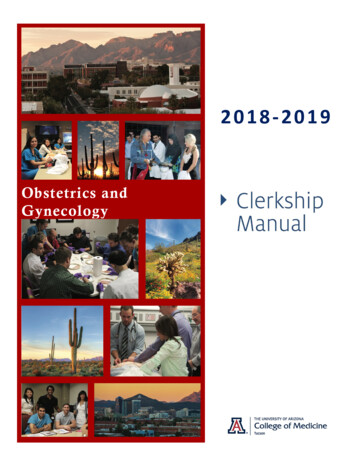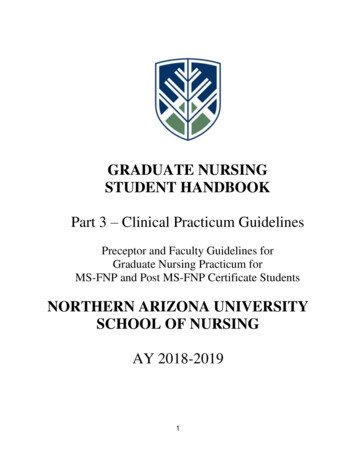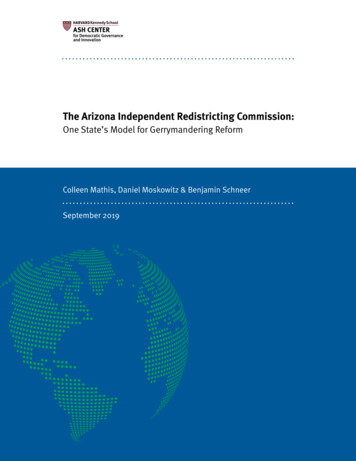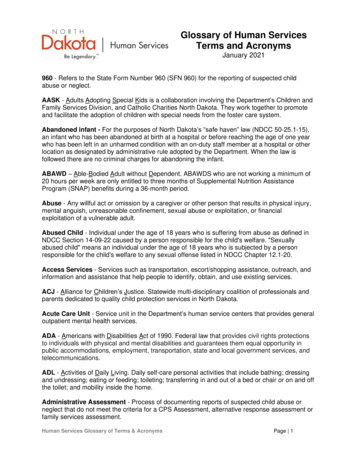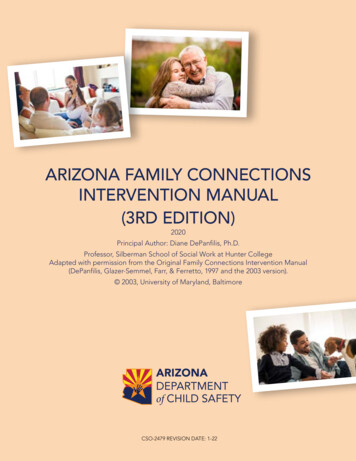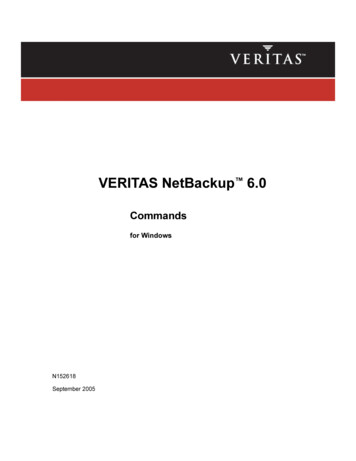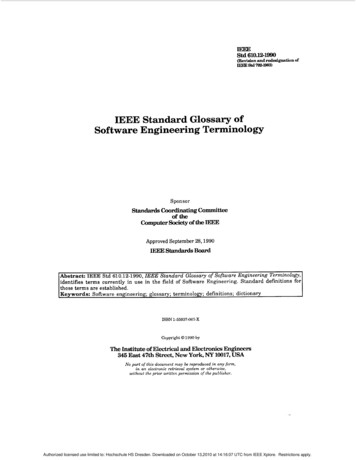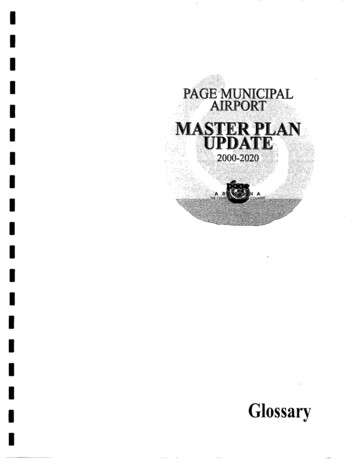
Transcription
IIIIIIIIIIIIIIIIIIIGlossary
IIIIIIIIIIIIIIIIIIIGlossaryAIR CARRIER - A commercial operator engaging in the carriage of persons or property in aircommerce for compensation or hire. Air carriers are certificated in accordance with FAR Parts121 and 127, and generally operate aircraft having a seating capacity of more than 30passengers or a maximum payload capacity of more than 7,500 pounds.AIR ROUTE TRAFFIC CONTROL CENTER (ARTCC) - A facility established to providepositive air traffic control service to aircraft operating on IFR flight plans within controlledairspace. Controls only traffic en route between airports.AIR TAXI - Schedule and/or nonscheduled aircraft operations carrying passengers and/or cargofor compensation. The capacity of air taxi aircraft is limited by Part 135 of the Federal AviationRegulations.AIR TRAFFIC - Aircraft operating in the air or on an airport surface, excluding loading ramps andparking areas.AIRCRAFT APPROACH CATEGORY - A grouping of aircraft based on a speed of 1.3 times thestall speed in the landing configuration at maximum gross landing weight. An aircraft shall fit inonly one category. If it is necessary to maneuver at speeds in excess of the upper limit of aspeed range for a category, the minimum for the next higher category should be used. Thecategories are as follows:Category A - SpeedCategory B - SpeedCateqory C - SpeedCate,qory D - SpeedCate.qory E - Speedless than 91 knots.91 knots or more but less than 121 knots.121 knots or more but less than 141 knots.141 knots or more but less than 166 knots.166 knots or more.AIRCRAFT MIX - The number of aircraft movements categorized by capacity group oroperational group, and specified as a percentage of the total aircraft movements.AIRCRAFT OPERATION - An aircraft takeoff or landing.AIRPLANE DESIGN GROUP (PHYSICAL CHARACTERISTICS) - The airplane design groupsubdivides airplanes by wingspan. The airplane design group concept links an airport'sdimensional standards to aircraft approach categories or to airplane design groups or to runwayinstrumentation configurations. The airplane design groups are:1. Airplane Design Group !:Wingspan up to but not including 49 feet.2. Airplane Design Group I1: Wingspan 49 feet up to but not including 79 feet.3. Airplane Design Group II1: Wingspan 79 feet up to but not including 118 feet.4. Airplane Design Group IV: Wingspan 118 feet up to but not including 171 feet.5. Airplane Design GroupV:Wingspan 171 feet up to but not including 197 feet.6. Airplane Design GroupVl: Wingspan 197 feet up to but not including 262 feet.Glossary- Page 1 of 22
Page Municipal Airport Master Plan UpdateAIRPORT CLASSIFICATIONS - T h e r e are four aviation facility classifications used by the FAAand the Arizona Department of Transportation. The first classification system utilizes the systemin the National Plan of Integrated Airport Systems (NPIAS). The second system is used by theFAA to relate airport design criteria to the operational and physical characteristics of theairplanes. The third is a hierarchical classification used by the ADOT Aeronautics Division. Thefourth was developed by ADOT based on FAA airport classification categories.NPIAS Classifications:Primary Service (PR) - Primary Service airports are public use airports receivingscheduled airline passenger service which also enplane 10,000 or more passengers peryear.Commercial Service (CM) - Commercial Service airports are public use airports whichreceive scheduled airline passenger service and which annually enplane 2,500 or more.General Aviation (GA) - General Aviation airports are either publicly or privately ownedpublic use airports which serve general aviation users.Reliever (RL) - Reliever airports are general aviation or commercial service airportswhich have the function of relieving congestion at a Primary Service airport.ADOT Classifications: Primary system airports must be open to the public and meet at least one of thefollowing criteria: Have 10 or more based aircraft and/or 2,000 or more yearly operations; or Have scheduled air carrier service; or Receive commuter service regularly; or Are projected to meet any of the above criteria within 10 years. Secondary airports is one that satisfies both following criteria: (1) recognized by theFAA as an airport per Form 5010 and (2) open to the public. Emerging Rural Airports are airport facilities that do not meet requirements of eitherthe Primary or Secondary systems of airports, but exist in areas that are notadequately served by aviation facilities or have demonstrated a need for suchfacilities, or have not been registered with the FAA.ADOTIFAA Classifications: New/Emerging: This category accommodates areas within the State of Arizona thatdemonstrate a need for an airport with minimum design standards to be utilized forgeneral aviation, recreation, and/or emergency services. Basic Utility - Stage I - This type of airport serves about 75% or the single-engine andsmall twin-engine airplanes used for personal and business purposes. Precisionapproach operations are not usually anticipated. Basic Utility - Stage II - This type of airport serves all the airplanes in Stage I, plus somesmall business and air taxi-type twin-engine airplanes. Precision approach operationsare not usually anticipated. General Utility - Stage I - This type of airport serves all small airplanes. Precisionapproach operations are not usually anticipated. This airport is also designed for smallairplanes in Airplane Design Group I.Glossary - Page 2 of 22IIIIIIII
IIIIIIIIIiIIIIIIIlIPage Municipal Airport Master Plan UpdateGeneral Utility - Stage II - This type of airport serves large airplanes in Aircraft approachCategory A and B and usually has the capability for precision approach operations. Thisairport is normally designed for Airplane Design Groups I and II. It may also be designedto serve Aircraft Approach Category A large airplanes in Airplane Design Group III.Commercial Service - An airport with regularly scheduled airline service.AIRPORTELEVATION/FIELDELEVATION- The highest point of an airport's runwaysmeasured in feet from mean sea level.A I R P O R T L A Y O U T PLAN (ALP) - A graphic presentation, to scale, of existing and proposedairport facilities, their location on the airport, and the pertinent clearance and dimensionalinformation required to show conformance with applicable standards. To be eligible for AlPfunding assistance, an airport must have an FAA-approved Airport Layout Plan.A I R P O R T LIGHTING - Various lighting aids that may be installed on an airport. Types of airportlighting include:. Approach Light System/ALS: An airport lighting facility which provides visualguidance to landing aircraft by radiating light beams in a directional pattern by whichthe pilot aligns with the extended centerline of the runway on his final approach forlanding. Types of Approach Light Systems are:a) ALSF-I: Approach Light System with Sequenced Flashing Lights in ILS Cat-Iconfiguration.b) ALSF-II: Approach Light System with Sequenced Flashing Lights in ILS Cat-IIconfiguration.c) SSALF:Lights.Simplified Short Approach Light System with Sequenced Flashingd) SSALR: Simplified Short Approach Light System with Runway AlignmentIndicator Lights.e) MALSF:Lights.f)Medium Intensity Approach Light System with Sequenced FlashingMALSR: Medium Intensity Approach Light System with Runway AlignmentIndicator Lights.g) LDIN: Sequenced Flashing Lead-in Lights.h) RAIL: Runway Alignment Indicator Lights (Sequenced Flashing Lights which areinstalled only in combination with other light systems).i)ODALS:Omnidirectional Approach Lighting System consists of sevenomnidirectional flashing lights located in the approach area of a non-precisionrunway. Runway Lights/Runway Edge Lights: Lights having a prescribed angle of emissionused to define the lateral limits of a runway. Runway lights are uniformly spaced atintervals of approximately 200 feet, and the intensity may be controlled or preset. Touchdown Zone Lighting: Two rows of transverse light bars locatedsymmetrically about the runway centerline normally at 100-foot intervals. The basicsystem extends 3,000 feet along the runway.Glossary - Page 3 of 22
Page Municipal Airport Master Plan Update4.Runway Centerline Lighting: Flush centerline lights spaced at 50-foot intervalsbeginning 75 feet from the landing threshold and extending to within 75 feet of theopposite end of the runway.5. Threshold Lights: Fixed green lights arranged symmetrically left and right of therunway centerline, identifying the runway threshold.6. Runway End Identifier Lights/REIL: Two synchronized flashing lights, one on eachside of the runway threshold, which provide rapid and positive identification of theapproach end of a particular runway.7. Visual Approach Slope IndicatorNASl: An airport lighting facility providing verticalvisual approach slope guidance to aircraft during approach to landing by radiating adirectional pattern of high intensity red and white focused light beams which indicateto the pilot that he is "on path" if he sees red/white, "above path" if white/white, and"below path" if red/red.8. Precision Approach Path Indicator/PAPl: (same function and description as forVASI but different configuration).9. Boundary Lights: Lights defining the perimeter of an airport or landing area.A I R P O R T M A S T E R PLAN - An assembly of appropriate documents and drawings covering thedevelopment of a specific airport from a physical, economical, social, and political jurisdictionalperspective. The airport layout plan is a part of this plan.A I R P O R T NOISE A B A T E M E N T P R O G R A M - A program designed to mitigate noise impactsaround an airport through changes in the manner in which aircraft are flown, or changes in theoperation or layout of the airport.A I R P O R T O V E R L A Y Z O N E - A zone intended to place additional land use conditions on landimpacted by the airport while retaining the existing underlying zone.A I R P O R T R E F E R E N C E C O D E (ARC) - A coding system of aircraft approach speed andwingspan used to related to operational and physical airport design standards.A I R P O R T R E F E R E N C E POINT (ARP) - An ARIP is a point having equal relationship to allexisting and proposed landing and takeoff areas which is used to locate the airportgeographically.A I R P O R T R E S C U E A N D FIRE F I G H T I N G (ARFF) - Airport rescue and fire fighting facilities,including vehicles, personnel, and buildings.A I R P O R T R O T A T I N G B E A C O N - A visual NAVAID operated at many airports. At civil airports,alternating white and green flashes indicate the location of the airport.A I R S I D E - Portion of the airport directly related to the arrival and departure of aircraft, includingsuch airfield facilities as runways, taxiways, navigational aids, marking, and lighting.LANDSIDE).(SeeA I R S P A C E - Space above the ground in which aircraft travel, divided into corridors, routes, andrestricted zones.Glossary - Page4 of 22iIIiIIIi
iiIIIIIIIIIIIIIiIIiPage Municipal Airport Master Plan UpdateC O N T R O L T O W E R ( A T C T ) - A facility at an airport operated by appropriateauthority to promote the safe, orderly and expeditious flow of air traffic within an airport trafficarea.AIR TRAFFICN O I S E - All encompassing noise associated with a given environment, being usuallya composite of sounds from many sources near and far.AMBIENTASV is a reasonable estimate of an airport's annualcapacity. It accounts for differences in runway use, aircraft mix, weather conditions, etc., thatwould be encountered over a year's time.ANNUALSERVICEVOLUME(ASV) -A N D R P Z P L A N - The Approach and RPZ Plan is compiled from the criteria in FARPart 77, Objects Affecting Navigable Airspace. It shows the area affected by the AirportObstructions Zoning Ordinance and includes layout of runways, airport boundary, elevations, andarea topography. Applicable height limitation areas are shown in detail.APPROACHS L O P E S - The ratios of horizontal to vertical distance indicating the degree ofinclination of the Approach Surface. The various ratios include:APPROACH20:1For all utility and visual runways extended from the primary surface a distance of5,000 feet.34:1For all non-precision instrument runways other than utility extended from theprimary surface for a distance of 10,000 feet.50:1/40:1For all precision instrument runways extending from the primary surface for adistance of 10,000 feet at an approach slope of 50:1 and an additional 40,000 feetbeyond this at a 40:1 Approach Slope.An element of the airport imaginary surfaces longitudinally centered onthe extended runway centerline, extending outward and upward from the end of the primarysurface at a designated slope.APPROACHSURFACE-INSTRUMENT APPROACH- An instrument approach approved for general useand publication by the FAA. It must meet design, accuracy, and equipment requirements set bythe FAA, and is subject to periodic FAA flight checks.APPROVED- An area designated for aircraft use, other than taxiways and runways.Example uses for an apron include loading and unloading, parking, maintenance, refueling,before take-off engine run up, and as a temporary traffic holding area.APRON/RAMPN A V I G A T I O N ( R N A V ) - A method of navigation that permits aircraft operation on anydesired course within the coverage of station-referenced navigation signals or within the limits ofa self-contained system capability.AREADEPARTMENTOF TRANSPORTATION( A D O T ) - Arizona Department ofTransportation - An agency of the State of Arizona government responsible for planning, design,construction and maintenance of transportation facilities.ARIZONAGlossary- Page5 of 22
Page Municipal Airport Master Plan UpdateD I R E C T I O N F I N D E R ( A D F ) - An aircraft radio navigation system, which sensesand indicates the direction to a Non-Directional radio beacon (NDB), ground transmitter.Direction is indicated to the pilot as a magnetic bearing or as a relative bearing to the aircraft,depending on the type of indicator installed in the aircraft.AUTOMATICF L I G H T S E R V I C E S T A T I O N ( A F S S ) - An air traffic facility, which provides pilotbriefing and en route communications; receives and processes flight plans; and offers otherservices to aviators. Some of these services are provided on an automated basis.AUTOMATEDW E A T H E R O B S E R V A T I O N S Y S T E M ( A W O S ) - system of equipment thatprovides around-the clock, real-time weather information at airports without adequate weatherobservation personnel. The basic system consists of weather sensors to measure wind speedand direction, temperature, dewpoint, pressure, precipitation, visibility, cloud height, and densityaltitude.AUTOMATEDIn addition to AWOS data,ASOS provides information on the degree and precipitation (i.e., rain, sleet, snow, freezing rain)received in the observation area.AUTOMATEDSURFACEOBSERVATIONSYSTEM(ASOS) -T E R M I N A L I N F O R M A T I O N S E R V I C E (ATIS) - The continuous broadcast ofrecorded non-control information intended to improve controller effectiveness and relievefrequency congestion by automating the repetitive transmission of essential but routineinformation.AUTOMATICAVIGATION AND HAZARD EASEMENT- An easement that provides right of flight at anyaltitude above the approach surface, prevents any obstruction above the approach surface,provides a right to cause noise vibrations, prohibits the creation of electrical interference's andgrants right-of-way entry to remove trees or structures above the approach surface.B A S E D A I R C R A F T - An aircraft permanently stationed at an airport.L I N E ( B R L ) - A line shown on the Airport Layout Plan beyond whichairport buildings must not be positioned in order to limit their proximity to aircraft movementareas.BUILDING RESTRICTIONC A P A C I T Y - Capacity (throughput capacity) is a measure of the maximum number of aircraftoperations, which can be accommodated on the airport component in an hour. Since thecapacity of an airport component is independent of the capacity of other airport components, itcan be calculated separately.COMMERICALS E R V I C E - Commercial service airports are public-use airports, which receive,scheduled passenger service aircraft and which annually enplane 2,500 or more passengers.C O M M U T E R A I R C A R R I E R - An air carrier, certified in accordance with FAR Part 135, whichoperates aircraft with a maximum of 60 seats and provides at least five schedule round trips perweek between two or more points, or which carries mail.P L A N - A set of public decisions dealing with how the land, air, and waterresources of an area are to be used. The plan provides for all resources, uses, public facilities,COMPREHENSIVEGlossary - Page 6 of 22IIil
IIIIIIIIIIIIIIIIIIIPage Municipal Airport Master Plan Updateand services in an area. It also incorporates the plans and programs of the variousgovernmental units into a single management tool for the planning area.A land use regulatory procedure in which an applicant must adhere to"standards for approval" as established by local officials. A conditional-use procedure allowsextensive public review of any development being considered.CONDITIONALUSE -A I R S P A C E - An airspace of defined dimensions which air traffic control serviceis provided to IFR flights and to VFR flights in accordance with the airspace classification.CONTROLLEDa.Controlled airspace is a generic term that covers Class A, Class B, Class C,Class D and Class E airspace.b.Controlled airspace is also that airspace within which all aircraft operators aresubject to certain pilot qualifications, operating rules and equipment requirementsin FAR Part 91 (for specific operating requirements, please refer to FAR Part 91).For IFR operations in any class of controlled airspace, a pilot must file an IFRflight plan and receive an appropriate ATC clearance. Each Class B, Class Cand Class D airspace area designated for an airport contains at least one primaryairport around which the airspace is designated (for specific designations anddescriptions of the airspace classes, please refer to FAR Part 71).c.Controlled airspace in the United States is designated as follows:1.CLASS Generally, that airspace from 18,000 feet MSL up to andincluding FL 600, including the airspace overlying the waters within 12nautical miles of the coast of the 48 contiguous States and Alaska.Unless otherwise authorized, all persons must operate their aircraft underIFR.2.CLASS B: Generally, that airspace from the surface to 10,000 feet MSLsurrounding the nation's busiest airports in terms of airport operations orpassenger enplanements. The configuration of each Class B airspacearea is individually tailored and consists of a surface area and two or morelayers (some Class B airspace areas resemble upside-down weddingcakes) and is designed to contain all published instrument proceduresonce an aircraft enters the airspace. An ATC clearance is required for allaircraft to operate in the area, and all aircraft that are so cleared receiveseparation services within the airspace. The cloud clearance requirementfor VFR operations is "clear of clouds."3.C L A S S C: Generally, that airspace from the surface to 4,000 feet abovethe airport elevation (charted in MSL) surrounding those airports that havean operational control tower, are serviced by a radar approach control,and that have a certain number of IFR operations or passengerenplanements. Although the configuration of each Class C area isindividually tailored, the airspace usually consists of a surface area withina 5 nautical mile (NM) radius, an outer circle with a 10NM radius thatextends from 1,200 feet to 4,000 feet above the airport elevation and anouter area. Each person must establish two-way radio communicationswith the ATC facility providing air traffic services prior to entering theairspace and thereafter maintain those communications while within theairspace. VFR aircraft are only separated from IFR aircraft within theairspace. (See OUTER AREA.)Glossary- Page7 of 22
Page Municipal Airport Master Plan UpdateCONVENTIONAL.CLASS D: Generally, that airspace from the surface to 2,500 feet abovethe airport elevation (charted in MSL) surrounding those airports that havean operational control tower. The configuration of each Class D airspacearea is individually tailored and when instrument procedures arepublished, the airspace will normally be designed to contain theprocedures. Arrival extensions for instrument approach procedures maybe Class D or Class E airspace. Unless otherwise authorized, eachperson must establish two-way radio communications with the ATCfacility providing air traffic services prior to entering the airspace andthereafter maintain those communications while in the airspace. Noseparation services are provided to VFR aircraft.CLASS E: Generally, if the airspace is not Class A, Class B, Class C orClass D, and it is controlled airspace, it is Class E airspace. Class Eairspace extends upward from either the surface or a designated altitudeto the overlying or adjacent controlled airspace. When designated as asurface area, the airspace will be configured to contain all instrumentprocedures. Also in this class are Federal airways, airspace beginning ateither 700 or 1,200 feet AGL used to transition to/from the terminal or enroute environment, en route domestic and offshore airspace areasdesignated below 18,000 feet MSL. Unless designated at a lower altitude,Class E airspace begins at 14,500 MSL over the United States, includingthat airspace overlying the waters within 12 nautical miles of the coast ofthe 48 contiguous States and Alaska, up to, but not including, 18,000 feetMSL and the airspace above FL 600.HANGAR-A large building used to store more than one aircraft and/or toconduct aircraft maintenance.C R I T I C A L A I R C R A F T - In airport design, the aircraft which controls one or more design itemssuch as runway length, pavement strength, lateral separation, etc., for a particular airport. Thesame aircraft may not be critical to all design items.CROSSWlNDRUNWAY - A runway additional to the primary runway to provide for windcoverage not adequately provided by the primary runway.With respect to the operation of aircraft, DH means the height atwhich a decision must be during an ILS instrument approach to either continue the approach orto execute a missed approach.DECISIONHEIGHT(DH) -D E P E N D E N T V A R I A B L E - The variable that is of interest to the researcher, the variable that isnot forecast. In regression analysis, the variable on the left-hand side of the equation.DISPLACEDTHRESHOLD- A threshold located at a point on the runway other than at therunway end. Except for the approach standards defined in FAR Part 77, approach surfaces areassociated with the threshold location.DISTANCEMEASURINGEQUIPMENT( D M E ) - A navigation ground station capable ofreceiving interrogations from aircraft and transmitting signals which allow time, speed, anddistance computations to be made. The station is usually sited with VOR and, at times, an ILS.G l o s s a r y - Page 8 of 22IIII
IiIIIIIIIIIIIIIIIIiPage Municipal Airport Master Plan UpdateEASEMENT- The legal right held by one party to make use of the land of another for a limitedpurpose.ECONOMETRICMETHODS- Regression correlation techniques applied to a great variety offorecasting problems to ascertain the relationships between the dependent variables and suchexplanatory and logically relevant economic variables as income, demographic variables suchas population, and other market factors, such as usage impedance and intermodal competition.(See Regression Equation)E N V I R O N M E N T A L A S S E S S M E N T (EA) - A concise public document, prepared under theguidelines of the National Environmental Policy Act of 1969, and for which a federal agency isresponsible that serves to:1. Briefly provide sufficient evidence and analysis for determining whether to prepare anenvironmental impact statement or a finding of no significant impact.2. Aid an agency's compliance with the Act when no environmental impact statement isnecessary.3. Facilitate preparation of a statement when one is necessary.It includes brief discussions of the need for the proposal, of alternatives as required, of theenvironmental impacts of the proposed action and alternatives, and a listing of agencies andpersons consulted.ESSENTIALAIR SERVICE- The Department of Transportation's Essential AirPROGRAMService program (Payments to Air Carriers) was created as a transition program in 1978following airline deregulation. Its purpose was to ensure continued inexpensive air service to thesmall communities the airlines previously had been mandated to serve. The program currentlyspends about 26 million annually to subsidize commuter service to roughly 70 communities in27 contiguous states, Hawaii, and about 30 communities in Alaska. Communities eligible for thesubsidy must be more than 70 miles from a medium to large airport, although some exceptionsare NTPROGRAM(ALP) -Agrant-in-aid program funded by the Airport and Airway Trust Fund.FEDERAL AVIATION REGULATIONS(FAR), P A R T 36 - FAR Part 36 contains noisecertifications standards for most airplane types, generally requiring newly designed andmanufactured aircraft to be significantly quieter than older aircraft.F E D E R A L A V I A T I O N R E G U L A T I O N S (FAR), P A R T 77 - Part 77, Objects Affecting NavigableAirspace, establishes standards for determining obstructions to navigable airspace.FEDERAL AVIATION REGULATIONS(FAR), P A R T 150 - Implements portions of Title I of theAviation Safety and Noise Abatement Act. It specifically establishes a single system for themeasurement of airport (and background) noise, a single system for determining the exposure ofindividuals to airport noise, and a standardized airport noise compatibility planning program.F I X E D B A S E O P E R A T O R ( F B O ) - A private firm providing airport services such as fuel sales,aircraft maintenance, aircraft rental, and flight instruction.Glossary - Page 9 of 22
Page Municipal Airport Master Plan UpdateFLIGHTSERVICESTATION(FSS) -A facility operated by the FAA to provide flight serviceassistance.A V I A T I O N ( G A ) - The portion of civil aviation which includes all facets of aviationexcept scheduled air carriers falls into four (4) major categories:1. Business: The use of an aircraft for executive or business transportation. This categoryconsists of aircraft used by an organization and operated by professional pilots to transportits employees and property (not for compensation of hire); and aircraft used by an individualfor transportation required for business.2. Commercial: The use of an aircraft for commercial purposes (other than the commuter andair carrier), including: air taxi, aerial application, special industrial usage, aerial surveys,advertising, aerial photography, and emergency medical transportation.3. Instructional: The use of an aircraft for flight training under the supervision of an instructor.4. Personal: The use of an aircraft for a variety of personal reasons.GENERALA V I A T I O N A I R P O R T - General Aviation airports are either publicly or privately ownedairports which serve general aviation aircraft users.GENERAL(GS) - Provides vertical guidance for aircraft during approach and landing. Theglide slope consists of the following:GLIDE SLOPE1. Electric components emitting signals which provide vertical guidance by reference toairborne instruments during instrument approaches such as an ILS, or2. Visual ground aids, such as VASI, which provide vertical guidance for a VFRapproach or for the visual portion of an instrument approach and landing.G L O B A L P O S I T I O N I N G S Y S T E M ( G P S ) - A satellite-based navigational system operated bythe United States Department of Defense and made available for civilian use for en routenavigation, aircraft instrument approaches and other purposes.ABOVE TOUCHDOWN( H A T ) - The height of the decision height or minimum descentaltitude above the highest runway elevation in the touchdown zone (first 3,000 feet of therunway). HAT is a published on instrument approach chart in conjunction with all straight-inminimums. (See DECISION HEIGHT, MINIMUM DESCENT ALTITUDE).HEIGHTA small, designated area, usually with a prepared surface, on a heliport, airport,landing/takeoff area, apron/ramp, or movement area used for takeoff, landing, or parking ofhelicopters.HELIPAD-HARMLESS AGREEMENT- An agreement that holds airport sponsors or jurisdictionsharmless from alleged damages resulting from airport operations. Such agreements arerecorded in deeds or permits as a condition of approval of a regulatory land-use decision.HOLDIFR CONDITIONS-Weather conditions below the minimum for flight under visual flight rules(VFR).Glossary - Page 10 of 22I,!
IIIIIIIIIIIIIIIIIIIPage Municipal Airport Master Plan UpdateI M A G I N A R Y S U R F A C E S - Those areas established in relation to the airport and to each runwayconsistent with FAR Part 77 in which any object extending above these imaginary surfaces is, bydefinition, an obstruction.VARIABLE- An indicator on the basis of which the dependent variable isprojected. The Independent Variable may or may not cause the interval change in a dependentvariable with which it is associated.INDEPENDENTAPPROACH - The act of making an approach to an airport solely by referenceto instruments. To be counted in FAA statistics as an instrument approach, the aircraft mustdescend through clouds at some interval from the initial approach fix to the airport.INSTRUMENTAPPROACHA I D - Any of several FAA-approved electronic aids designed toprovide guidance to pilots making instrument approach
Indicator Lights. g) LDIN: Sequenced Flashing Lead-in Lights. h) RAIL: Runway Alignment Indicator Lights (Sequenced Flashing Lights which are installed only in combination with other light systems). i) ODALS: Omnidirectional Approach Lighting System consists of seven omnidirectional flashing lights located in the approach area of a non .


